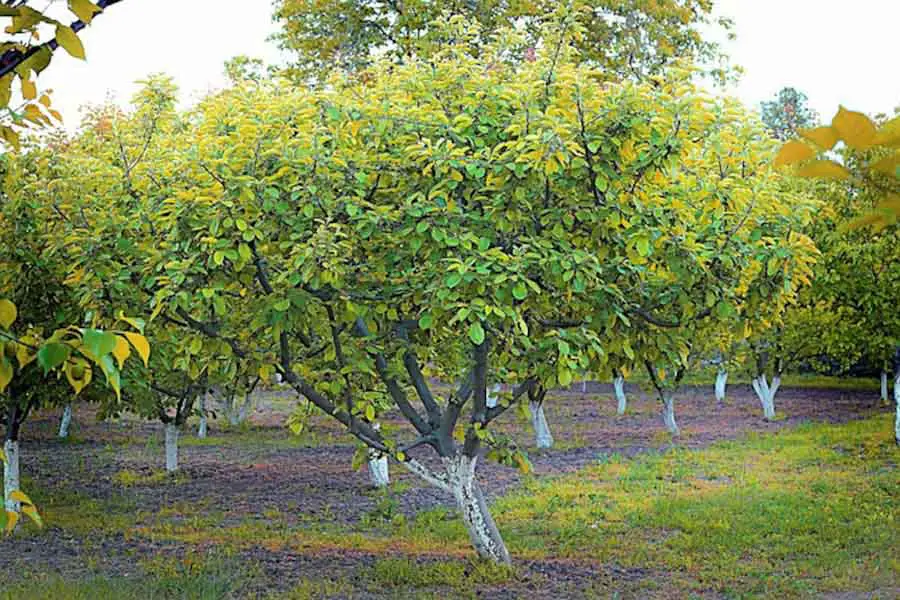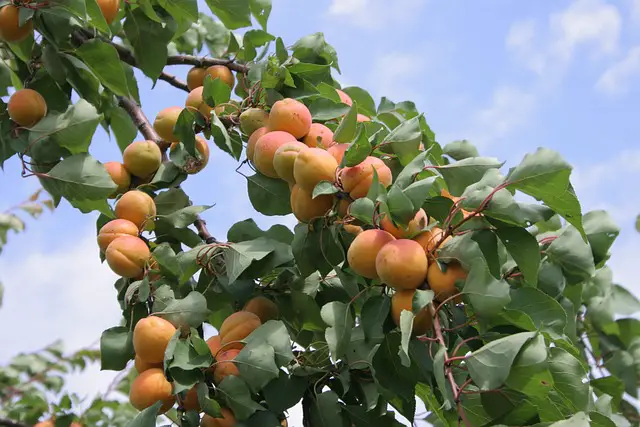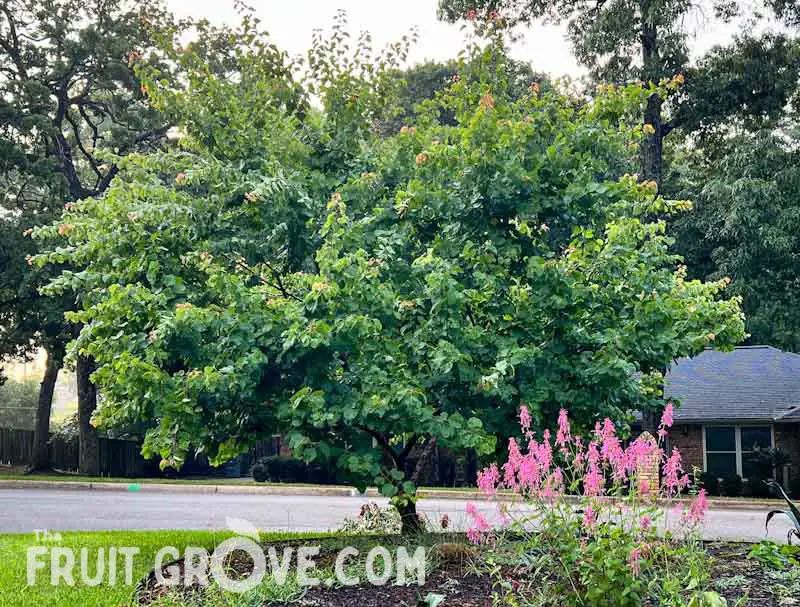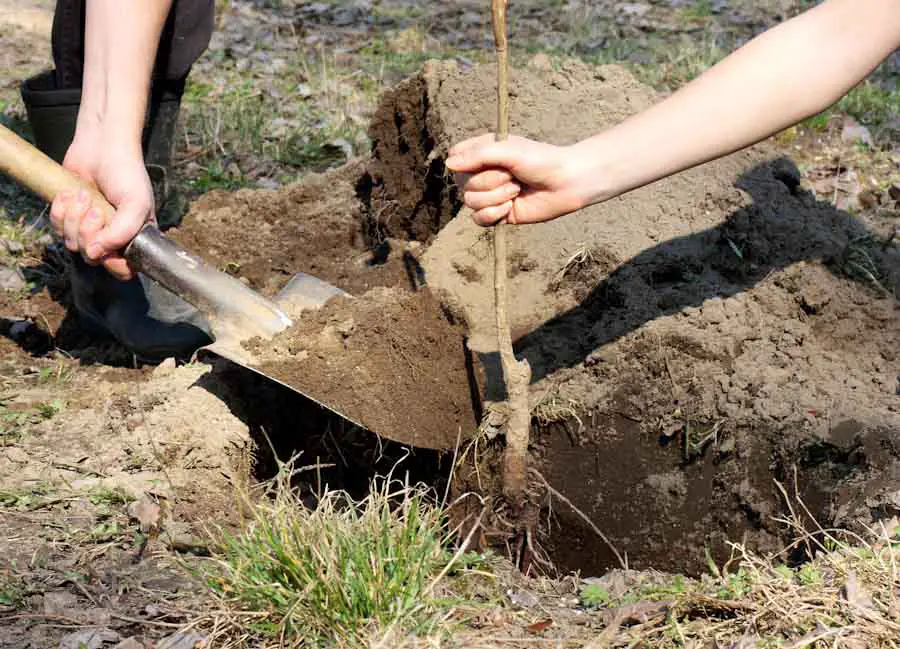
Buying any fruit tree is an investment, and apricot trees are no exception. Not only can they be expensive, but you are also committing time and effort year after year to care for the tree and help it thrive. One of the most important things you can do to protect that investment starts before you even purchase the tree – finding the right place to plant it.
Apricot trees are notoriously finicky and may fruit only sporadically in less-than-ideal conditions. In truth, apricot trees are easier to care for than most other stone fruits (peaches, I’m looking at you). But if you want your best chance at a bountiful crop of sweet, juicy apricots, the planting location is key. So what is the best spot for your apricot tree?
Apricot trees should be planted in an area with full sun and very well-draining soil. To protect against frost, plant near a fence or wall to take advantage of warmer microclimates. Avoid planting too close to root obstructions or overhanging objects, and locate cross-pollinating trees within 100 feet.
By planting an apricot tree in an ideal spot (or, as ideal as possible), you are doing your best to provide what it needs. This means less upkeep, better crops, and a healthier, long-lived tree. Who wouldn’t want that? Read on to learn what kind of location is best for an apricot tree, when to plant, and how exactly to do it.
The Perfect Place to Plant an Apricot Tree
Every fruit tree needs the right combination of sun, soil, space, and protection from the elements. An apricot tree planted in heavy shade, for example, or crowded with too many other trees, will have trouble thriving – let alone bearing fruit. Below is a breakdown of everything to consider when selecting a spot for your apricot tree.

Sun
Apricot trees need lots of sunlight to develop and ripen fruit. Plant the tree in full sun – a spot with at least 6 to 8 hours of direct light every day. Any less than that will dramatically decrease the quantity and quality of apricots the tree produces.
A slight exception to this is if you live in a very hot climate. Some dappled shade in the late afternoon can protect the tree from heat stress. This is especially helpful if you are growing a late-season apricot – the fruits are delicate and can be damaged by high heat. But, the tree should still get plenty of sunlight in the early part of the day.
Check out this article for apricot varieties that are perfect for hot climates and mild winters: The Tastiest Low-Chill Apricot Varieties to Grow at Home.
Soil
Apricot trees need fertile, but very well-draining soil. They are fairly adaptable to different soils, but sandy loam is best (a balance of sand and nutrient-holding organic matter).

The key is good drainage (as I’ll talk about below). Lean, less fertile soils are better than heavy clay soils, and can be overcome with a good fertilizing regimen. Heavy clay should be amended with organic matter that can improve drainage. Dig in compost, well-rotted manure, sphagnum peat moss, coir, or other organic material to help water drain through.
Drainage
Apricots do not do well with constantly wet soil. They are quite drought-tolerant, and thrive in arid, desert-like climates with stretches of dry weather. Winter moisture, in particular, is often the death of apricot trees, but any soil that holds onto water for too long is a problem.
Look for a spot that is slightly elevated – or if you don’t have one, create one. Apricot trees are often planted on mounds or raised beds so that the soil moisture can drain away. I have my ‘Golden Sweet’ apricot planted on a high spot in the corner of my front yard (picture below), which keeps the tree from having wet feet.

Spacing
Apricot trees need to be spaced as far apart as the eventual height of the tree. So, dwarf trees should be 8-10 feet apart, semi-dwarf 10-15 feet apart, and full size trees should be planted 15-20 feet apart.
Keep the tree planted 8 to 10 feet away from any potential root obstructions, such as patios or underground water and sewer lines. Check for overhead wires or taller trees that could be in the way as the apricot tree gets taller.
Consider any future plantings you may have planned, such as other fruit trees, and be sure to leave room. Apricot trees tend to have sprawling canopies and fairly wide-spread roots. Imagine its height as a full grown tree – it will get there before you know it!
Frost Protection
Apricot trees are notorious for falling victim to late frosts. This is because they are among the earliest bloomers of all fruit trees, which leaves the tender buds and young fruits susceptible to cold damage. There are a few things you can do to help prevent this (such as choosing a later-blooming apricot variety), but one of the most important is location selection.
Learn more: When Do Apricot Trees Flower? Best Varieties by Bloom Time

Planting an apricot tree on a mound can not only help with drainage, but can prevent frost from settling heavily on the tree. Have you ever noticed that the frost is thicker on low-lying areas, and lighter in high spots? Choose a spot that’s a little elevated, and your tree may have an easier time making it through a spring cold snap.
You can also plant the tree near a wall or fence to take advantage of the reflected heat. Areas like this are little microclimates in your yard – spots where the climate is slightly different than everywhere else. In this case it may be a few degrees warmer, which could be the difference between the buds dying and surviving.
Pollination
Most apricot trees are self-fertile, so they don’t need another tree to bear fruit. However, even a self-fertile tree will fruit better with a pollinizer nearby. The fruit will be more prolific and better quality when the blossoms have been pollinated by flowers from a different tree.
When you are deciding where to plant, consider whether you want a second tree somewhere else. As long as the trees are within about 100 feet, they will get the benefits of increased pollination.

Container
Still can’t find the perfect spot? Or maybe you realize you don’t have quite enough space? Thankfully, you have another option – container growing.
Apricot trees can grow well in pots. The same considerations of sun and soil apply, but they take up far less space. Some dwarf apricot varieties, such as ‘Garden Annie’, will stay only 8-10 feet tall even if planted in the ground. A dwarf tree will work best for pots, but any apricot tree can be kept smaller with pruning.
When is the best time to plant an apricot tree?
The best times to plant an apricot tree are during spring and fall, when the weather is relatively mild. The tree needs time to establish its roots before any harsh winter (or summer) weather sets in.
If you plant in the spring, wait until after the last possibility of frost has passed. The young tree will be sensitive to cold, and the last thing you want is for the first buds and tender leaves to be damaged by frost. Avoid stressing your newly planted tree – wait to plant in mild spring weather.
In the fall, plant the apricot tree at least six weeks before the first average frost date. This will give the tree time to establish before it needs to go dormant for the winter.
For those in climates with scorching summer temperatures (like me), it may be a good idea to wait until fall to plant your apricot tree. My zone 8b spring weather warms up quickly, so there’s a narrow window between the last frost date and rising temperatures. I planted my ‘Golden Sweet’ apricot tree in spring, but I had trouble keeping it watered adequately the first summer.

The tree died almost all the way back to the ground, and I just saved it by dousing it with a few gallons of water a day. New growth started above the graft union and grew vigorously as long as I kept it watered. Now, just a few years later, the tree is about 12 feet tall, and we just picked our first crop of the sweetest apricots I’ve ever tasted. Lesson learned – in my climate, planting in fall is a safer bet.
The opposite may be true for cooler climates. Planting in spring gives the tree a much better chance of establishing before winter. The fall may not be long enough for the tree to adjust before going dormant. If the young tree isn’t well-established, it could fall victim to winter damage.
How to Plant an Apricot Tree
Once you’ve chosen the right location at the right time of year, it’s time to plant. Here’s a quick guide to planting an apricot tree:

- Dig a hole 2 to 3 times wider than the root ball of the tree. If you’re planting a bare-root tree, dig a hole about 2 feet wide. Soak the bare roots in water for a few hours before planting.
- Amend the soil you’ve removed with compost or other organic material, if desired. Make sure the ratio of native soil to amendments is no more than 50-50 (at least half of the soil should be native).
- Loosen the root ball of the tree, and place it into the planting hole so the graft union is a few inches above the soil line. For bare-root trees, spread the roots in the hole before backfilling.
- Backfill the hole with the soil that was removed (and amended). Tamp down gently to remove air pockets. Create a soil ring around the planting hole a few inches high to make a “well” where water can collect and soak in gradually (be sure to tamp it down flat in the fall so water doesn’t freeze in the well). Water the newly planted tree thoroughly.
- Tie the young tree to a sturdy stake to support it as it establishes its roots in the ground. After several months, you should be able to remove the stake.

